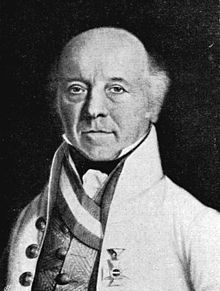Johann von Hiller
Johann Freiherr von Hiller († June 5, 1819 in Lemberg ) was an Austrian general and commander of the Maria Theresa Order . The information about Hiller's place and year of birth are different; 1748 in Modena or Wiener Neustadt and June 10, 1754 in Brody in Galicia .
Life
Johann von Hiller was the son of a colonel who had started his career as a simple soldier and was last commandant in Brody . He was 15 years old cadet . Kk in Infantry Regiment No. 8 and 1783 to lieutenant promoted. As captain of the Warasdin border regiment, he took part in the Turkish war under Laudon , became a major and lieutenant colonel, and finally received the Maria Theresa Order for storming Novi in 1788. For his services in the siege of Gradiška in 1789 he was promoted to colonel. In 1790 Laudon appointed him his adjutant general. From 1794 he was major general , in 1796 he commanded a brigade of the Rhine Army and took part in the war against France in the Netherlands, Italy and Germany until 1801 . He suffered a leg wound in the Battle of Zurich in 1799 and has been limping ever since.
In 1805 he was field marshal lieutenant and commanding general in Tyrol and Vorarlberg . After the surrender of Ulm , he was given the task of uniting with Archduke Charles' main army . He finally managed to do this through a skilful retreat to southern Styria. When the war broke out in 1809, he led the VI. Army corps in the army of Archduke Karl. Then other units were placed under him, so that he commanded all troops in Bavaria and Upper Austria. On April 20, Napoleon attacked him near Landshut and forced him to retreat. However, he succeeded in taking this on in full order and still remaining powerful. This enabled him to beat the French under Bessières on April 24 at Neumarkt an der Rott . For this act of arms he was awarded the Commander's Cross of the Maria Theresa Order. He went back to Linz via Burghausen and fought successfully on May 3rd in the battle of Ebelsberg , in which the Vienna Landwehr was also involved. In the battle of Aspern on May 21 and 22, he led the right wing and threw the enemy out of the place after stubborn fighting. The place changed hands nine times, but Hiller was finally able to assert himself there. After the victory he was promoted to Feldzeugmeister . Before the battle of Wagram , he resigned his command "because of a sudden and serious illness" (but in truth probably because of a difference of opinion with Archduke Karl).
In the campaign of 1813 he received command of the army in Inner Austria, which later became the "Italian Army". Although Eugen Beauharnais was superior to him in terms of strength, he was able to push him back over Tarvisio into the plain and further over Vicenza to Verona . But he did not succeed in taking the city himself. In 1814 he, who had meanwhile fallen ill, was appointed commanding general in Transylvania and later in Galicia . There he died after a long suffering. Johann von Hiller was called a " Radetzky of his time" because he was not only militarily successful, but also because of his care for the troops he was especially popular with the soldiers. As a Knight of Theresa he had already been raised to the rank of baron in 1789.
In 1896 Hillerstraße was named after him in Vienna- Leopoldstadt (2nd district) and Johann-Hiller-Straße in Klagenfurt . The Hiller barracks in Linz- Ebelsberg , in the immediate vicinity of the battlefield on May 3, 1809, is also named after him. Hiller was the regiment owner of Infantry Regiment No. 2.
literature
- Litschel: The battle near Ebelsberg on May 3, 1809 , Military History Series No. 9, Vienna 1983
- Manfried Rauchsteiner : Feldzeugmeister Johann Freiherr von Hiller (= dissertations from the University of Vienna . 80). Notring Verlag, Vienna 1972.
Individual evidence
- ^ Austrian Biographical Lexicon, accessed June 4, 2018
- ↑ Biography at futura-dtp.dk ( Memento from the Internet Archive from February 6, 2012)
- ↑ Hiller v. Butyin. J. Siebmacher's large and general book of arms. The nobility of Hungary with the neighboring countries of the St. Stephen's Crown (1893). Retrieved June 4, 2018
Web links
- Constantin von Wurzbach : Hiller, Johann Freiherr von . In: Biographisches Lexikon des Kaiserthums Oesterreich . 9th part. Kaiserlich-Königliche Hof- und Staatsdruckerei, Vienna 1863, pp. 20–26 ( digitized version ).
- Hiller Johann Frh. Von. In: Austrian Biographical Lexicon 1815–1950 (ÖBL). Volume 2, Verlag der Österreichischen Akademie der Wissenschaften, Vienna 1959, p. 317.
- Richard von Meerheimb : Hiller, Johann Freiherr von . In: Allgemeine Deutsche Biographie (ADB). Volume 12, Duncker & Humblot, Leipzig 1880, p. 423 f.
| personal data | |
|---|---|
| SURNAME | Hiller, Johann von |
| ALTERNATIVE NAMES | Hiller, Johann Freiherr von (full name) |
| BRIEF DESCRIPTION | Austrian general and commander of the Maria Theresa Order |
| DATE OF BIRTH | 18th century |
| DATE OF DEATH | June 5, 1819 |
| Place of death | Lviv |
